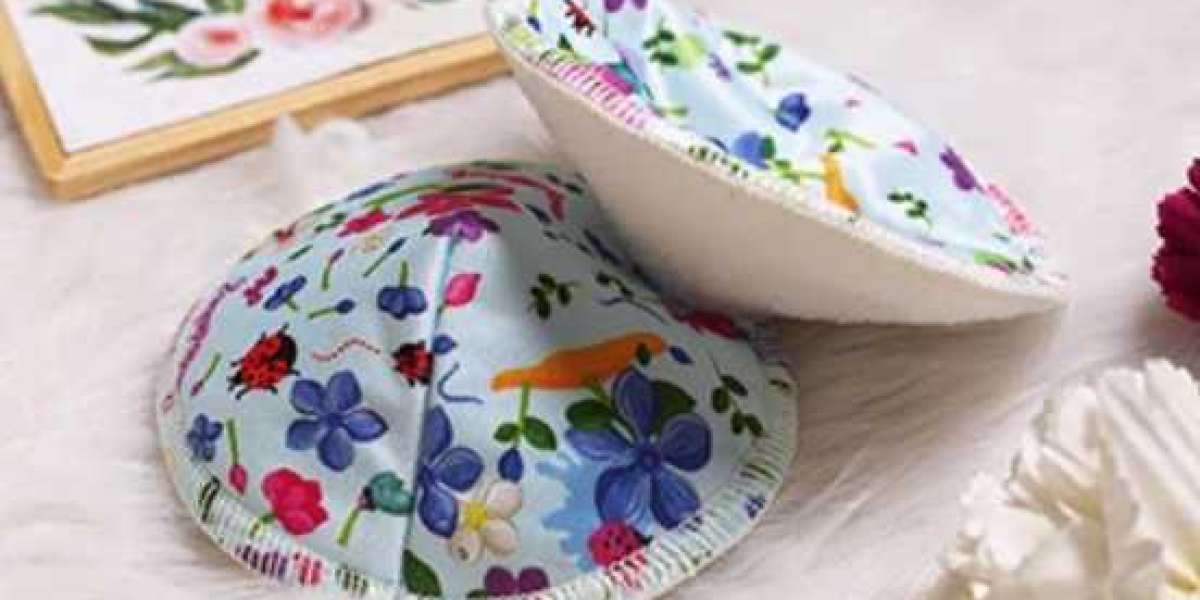Nursing pads are essential accessories for breastfeeding mothers, providing comfort and protection from leakage during the early weeks and months of breastfeeding. As the demand for sustainable products grows, more mothers seek eco-friendly alternatives to traditional disposable nursing pads, contributing to environmental waste. Mothers can reduce their carbon footprint by opting for eco-friendly nursing pads while enjoying the benefits of comfortable, absorbent, and cost-effective breastfeeding pads. This article will explore the advantages of eco-friendly nursing pads and highlight sustainable options that support a greener lifestyle.
Why Choose Eco-Friendly Nursing Pads?
Eco-friendly nursing pads (also known as boob pads or breastfeeding pads) offer numerous benefits for breastfeeding mothers, making them an attractive alternative to traditional disposable pads. Here are some compelling reasons to make the switch:
Environmental Benefits
- Reduced Waste: Disposable nursing pads contribute to the staggering amount of waste the healthcare industry generates. On the other hand, eco-friendly nursing pads can be washed and reused multiple times, significantly reducing the amount of waste sent to landfills.
- Conservation of Resources: Producing disposable nursing pads requires large amounts of water, energy, and raw materials. Mothers can help conserve these resources and reduce their carbon footprint by choosing eco-friendly nursing pads.
- Biodegradable Materials: Many eco-friendly nursing pads/breastfeeding pads are made from biodegradable materials, such as bamboo or organic cotton, which can easily decompose and return to nature.
Cost-Effectiveness in the Long Run
- Initial Investment: While eco-friendly nursing pads may require a higher initial investment, they can be washed and reused multiple times, making them a cost-effective option in the long run.
- Reduced Frequency of Purchases: Eco-friendly nursing pads allow mothers to reduce the frequency of their purchases, saving money and minimising waste.
- Longer Lifespan: Eco-friendly nursing pads are designed to last longer, with some brands offering a lifespan of 6-12 months.
Reduced Exposure to Chemicals for Mother and Baby
- Chemical-Free Materials: Eco-friendly nursing pads/breastfeeding pads/boob pads are made from chemical-free materials, reducing the risk of skin irritation and allergic reactions for both mother and baby.
- Breathable and Natural: Eco-friendly nursing pads are designed to be breathable and natural, allowing for airflow and moisture transfer, which can help prevent bacterial growth and odour.
- Healthier Skin: By choosing eco-friendly nursing pads, mothers can promote healthier skin for themselves and their babies, reducing the risk of skin conditions and allergies.
Types of Eco-Friendly Nursing Pads
When it comes to eco-friendly nursing pads, there are several options, each with its own unique features and benefits.
Reusable Fabric Nursing Pads
- Cotton: Organic cotton nursing pads (breast leaking pads) are a popular choice for eco-conscious mothers. They are soft, breathable, and highly absorbent, making them comfortable for long-term wear.
- Bamboo: Bamboo nursing pads are known for their exceptional absorbency, antimicrobial properties, and silky-soft feel. Bamboo is a rapidly renewable resource, making it an eco-friendly option.
- Hemp: Hemp nursing pads are durable, absorbent, and naturally antibacterial. They are a great choice for mothers with sensitive skin, as hemp is hypoallergenic.
Biodegradable Disposable Nursing Pads
In addition to reusable options, eco-friendly disposable nursing pads are also available. These pads are made from biodegradable materials, such as plant-based fibres, and can be composted or safely disposed of after use.
SuperBottoms Reversible Nursing Pads
One innovative eco-friendly option is the SuperBottoms reversible nursing pads. These pads feature a unique double-sided design, allowing mothers to use both sides before washing, effectively doubling the lifespan of the pads. The breast leaking pads are made from 100% organic cotton and are completely reversible, providing added convenience and sustainability.
Features and Benefits of SuperBottoms Reversible Nursing Pads:
- Organic cotton construction for comfort and breathability
- Double-sided design for extended use before washing
- Highly absorbent and leak-resistant
- Machine washable and durable for long-term use
- Eco-friendly and sustainable choice for breastfeeding mothers
- Available in a variety of colours and patterns to suit personal preferences
How to Use and Care for Reusable Nursing Pads
Proper care and maintenance of eco-friendly nursing pads are essential to ensure their longevity, effectiveness, and hygiene. Here's a comprehensive guide on using, cleaning, and storing reusable nursing pads.
Proper Washing and Drying Techniques
- Pre-wash: Before use, wash your new nursing breast pads to remove any manufacturing residues and increase absorbency.
- Regular Washing:
- Rinse pads in cold water immediately after use to prevent staining.
- Machine wash in warm water (30-40°C) with a mild, fragrance-free detergent.
- Avoid using fabric softeners, as they can reduce absorbency.
- For stubborn stains, pre-treat with a gentle stain remover before washing.
- Drying:
- Air drying is preferable to maintain the integrity of the pads.
- If using a dryer, use a low heat setting to prevent shrinkage and damage.
- Sunlight can naturally bleach and disinfect pads but avoid prolonged exposure to prevent fabric deterioration.
Storage Between Uses
- Clean Storage: Store clean, dry pads in a breathable container or mesh bag to prevent moisture buildup.
- On-the-Go Storage: When out, carry used pads in a small waterproof bag to keep them separate from clean pads.
- Rotation: Have enough pads to rotate through, allowing each set to dry completely between uses.
- Organization: Consider using different coloured pads for day and night use to distinguish between them easily.
When to Replace Eco-Friendly Breastfeeding Pads
While reusable nursing breast pads are designed for long-term use, they will eventually need replacement. Here are signs it's time for new pads:
- Reduced Absorbency: If pads no longer effectively absorb leaks, it's time to replace them.
- Visible Wear and Tear: Fraying edges, thinning fabric, or holes indicate it's time for new pads.
- Persistent Odor: If pads retain odours even after proper washing, consider replacing them.
- Staining: While some staining is normal, excessive or stubborn stains that don't come out in washing may warrant replacement.
- Change in Breast Size: As your breast size changes throughout your breastfeeding journey, you may need to adjust pad size for optimal fit and protection.
Comparison: Eco-Friendly vs. Traditional Nursing Pads
When choosing nursing breast pads, it's essential to consider various factors to ensure you select the best option for your needs and values. Eco-friendly nursing pads have gained popularity in recent years, but how do they stack up against traditional disposable options? Let's compare these two types of nursing pads across several key aspects to help you make an informed decision.
Aspect | Eco-Friendly Nursing Pads | Traditional Disposable Nursing Pads |
Absorbency and Leak Protection | - Generally, highly absorbent- May require more frequent changes- Some brands offer waterproof backing | - Designed for high absorbency- Often includes leak-proof barriers- Consistent performance |
Comfort and Breathability | - Made from natural, breathable materials- Can be more comfortable for sensitive skin- May feel bulkier under clothing | - Thin and discreet- May cause skin irritation for some users- Less breathable due to synthetic materials |
Cost Analysis | - Higher initial investment- Cost-effective over time- Typically last 6-12 months with proper care | - Lower upfront cost- Ongoing expense- Can be costly over the long term |
Environmental Impact | - Reusable and washable- Significantly reduces waste- Made from sustainable materials | - Single-use, contributing to landfill waste- Requires more resources for production- Often contains non-biodegradable materials |
This comparison highlights the critical differences between eco-friendly and traditional nursing pads. While eco-friendly options may require a higher initial investment, they offer long-term cost savings and significantly reduce environmental impact. Traditional disposable pads, on the other hand, provide convenience and consistent performance but come with ongoing costs and environmental concerns. Consider your priorities and lifestyle when choosing between these options to find the best fit for your breastfeeding journey.
In Conclusion
In conclusion, eco-friendly nursing pads offer a sustainable alternative to traditional disposable pads, reducing waste and conserving resources. While they may require a higher initial investment, they are cost-effective in the long run and provide a comfortable, breathable option for breastfeeding mothers. By choosing eco-friendly nursing pads, mothers can contribute to a more sustainable future for their families and the environment. Remember, every small step towards sustainability counts, and selecting eco-friendly nursing pads significantly reduces waste and promotes healthier living.
https://blognow.co.in/eco-friendly-nursing-pads-sustainable-options-for-a-greener-lifestyle














